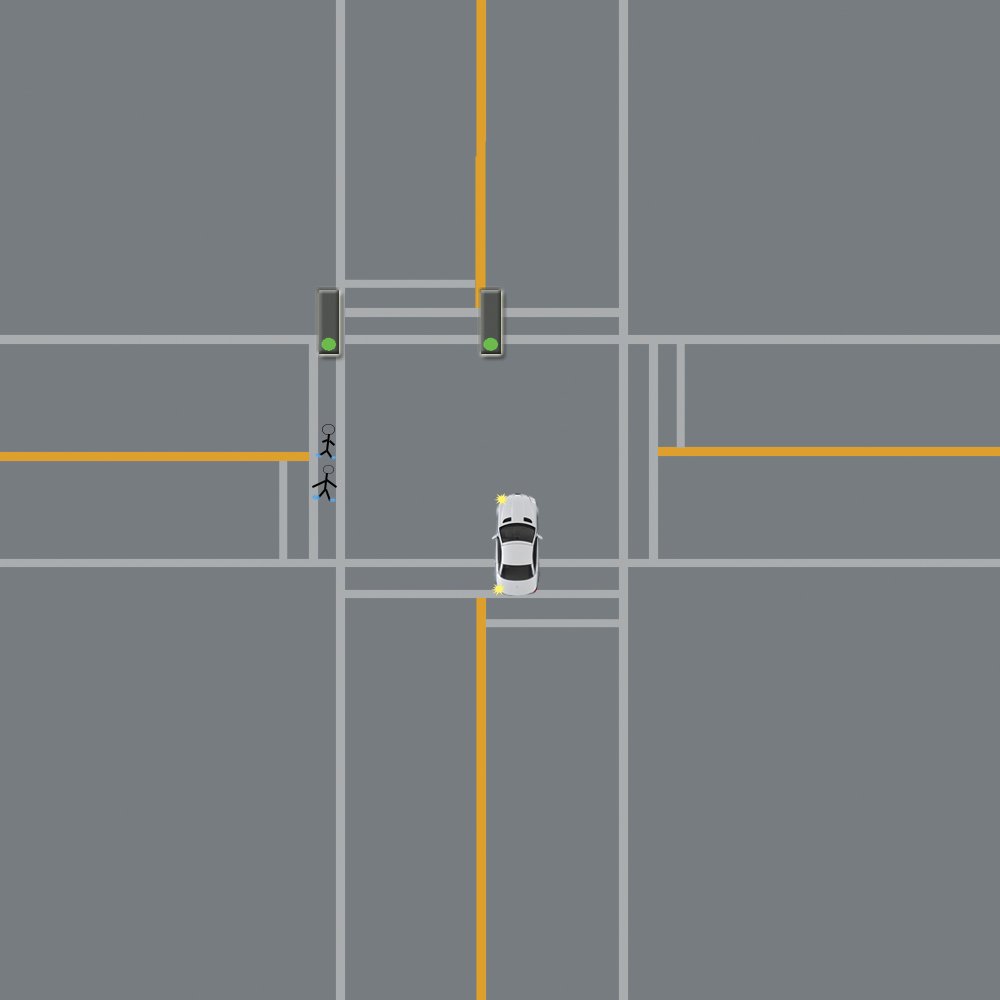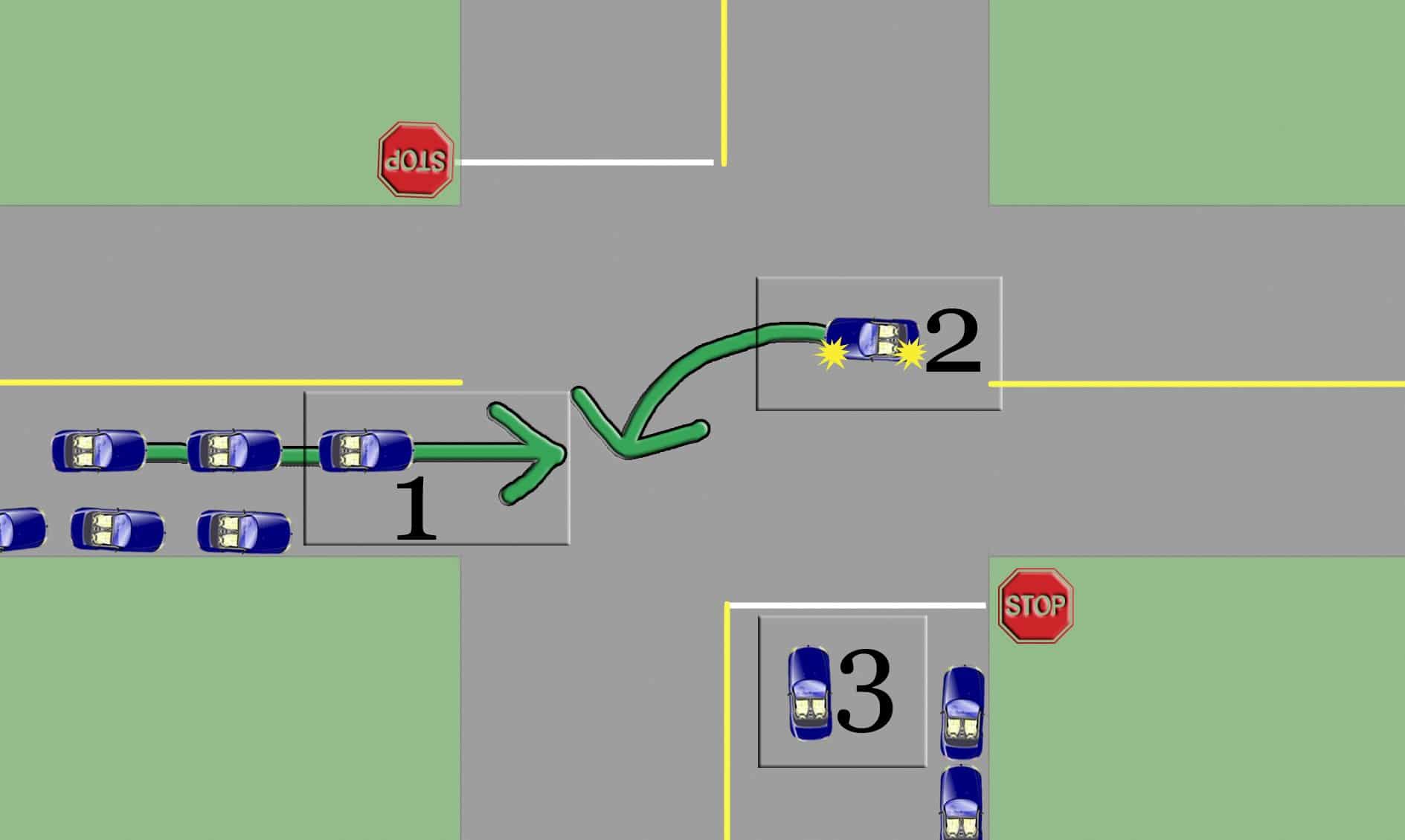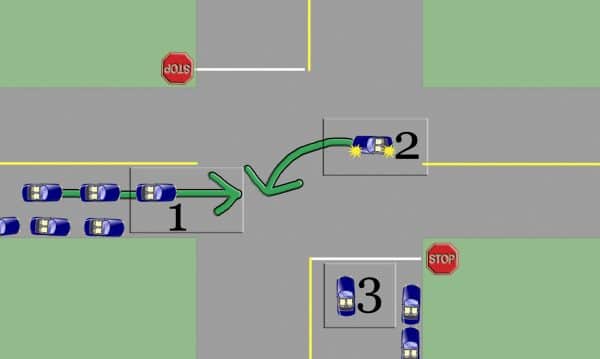Wondering if you should pull into the intersection for left turns?
Should I pull into the intersection? This is a common question, and it’s a great question. I’m going to answer this from my British Columbia, Canadian perspective. Other places might do things differently.
If you’re turning left on a green light, then yes, generally speaking, you should pull into the intersection when you’re yielding to oncoming traffic and/or pedestrians.
The only exception would be if there were no available spaces to turn into. This happens sometimes when the traffic is backed up on the other road. Or, sometimes there are issues on the road you’re about to turn into (a broken down car, construction, etc.)
Why pull into the intersection?
The reason you should pull into the intersection is it lines up your vehicle so that you have a short and efficient turn across traffic.
Turning left is generally considered dangerous, so it’s best to make this turn as short, quick, and efficient as possible so that you are not spending extra time crossing the oncoming lane or lanes.
There are also legal implications
When you enter an intersection on the green light, and if the traffic is busy and doesn’t allow you to turn, and then the light eventually changes to yellow or red, you’re still allowed to exit the intersection whenever it is safe to do so, regardless of the traffic light color. Check out our articles to read more about yellow lights, check out our full left-turning tutorial, or check out Carmen’s ICBC left-turning tutorial on YouTube.
Safety first when completing intersection turns
You should turn only when it is safe, regardless of the color of the traffic light. Simple. Since you entered the intersection when the light was green, you are legally allowed to leave the intersection whenever – and preferably as soon as, but not until – it is 110% safe to do so. The light may be yellow by then, or it may be red, and that is okay.
If you do not pull into the intersection
If you don’t pull into the intersection when the light is green (i.e. you’re waiting behind the white stopping line), then legally you aren’t allowed to leave the intersection once the light goes yellow or red.
This is because traffic lights – legally speaking – control traffic approaching intersections. Traffic lights do not control traffic that is already inside the intersection. In other words, traffic lights have no consequence once you are already inside the intersection.
So if you don’t enter it – and the traffic is very busy – you might be there all day long. And that would be unfortunate since the point of driving is to, like, get somewhere, not stay in the same place.
If you do turn once the light is yellow from the incorrect position behind the stopping line, then you’ll be in violation of the law, and/or you’ll be completing a dangerous turn, since other drivers likely won’t be expecting you to move from there, and your turn will be longer and inefficient since you’re starting it from a farther-away position.

2-way stops & pulling into the intersection
The same applies to a two-way stop sign intersection when you are on the street and are turning left and waiting for oncoming traffic.
If you don’t pull forward in this case, drivers at the stop sign may think you’re just a really nice person and you want them to go first; and that would be totally backward and confusing for others.
Isn’t this the whole point of stop signs? Drivers facing stop signs are supposed to wait for drivers who are not facing stop signs
If you pull forward a bit, you’ll be in their way, and they will understand – even if they have no idea how to drive – that you will be going first.
Pull forward so you have a short turn across traffic and avoid confusion. Collisions can happen when people are confused. Read more on our blog: What is Defensive Driving? 13 Rock Solid Tips & Strategy
Keep the car straight (generally speaking)
When you pull into the intersection
Remember to keep your vehicle and your wheels straight when waiting in case you are ever rear-ended (ICBC crash example).
If you get pushed straight forward, it’s probably not the end of the world. Compare that with what would happen if you were pushed into oncoming traffic and consider the consequences. Always select the lesser of two evils in life, whenever given the chance.


BC Motor Vehicle Act
Here is a section from the BC Motor Vehicle Act that explains how we should be doing left turns.
Turning at intersections
165
(2)When the driver of a vehicle intends to turn it to the left at an intersection where traffic is permitted to move in both directions on each highway entering the intersection, the driver must
(a)cause the vehicle to approach the intersection in the portion of the right side of the roadway that is nearest the marked centre line, or if there is no marked centre line, then as far as practicable in the portion of the right half of the roadway that is nearest the centre line,
(b)keep the vehicle to the right of the marked centre line or centre line of the roadway, as the case may be, at the place the highway enters the intersection,
(c)after entering the intersection, turn the vehicle to the left so that it leaves the intersection to the right of the marked centre line of the roadway being entered, or if there is no marked centre line then to the right of the centre line of the roadway being entered, and,
(d)when practicable, turn the vehicle in the portion of the intersection to the left of the centre of the intersection.
British Columbia Motor Vehicle Act
Conclusion
Generally speaking, we should always roll up into the intersection when waiting for a left turn. One reason we do this is to reduce confusion among other drivers. By pulling forward, you are indicating that you are seriously getting ready to turn or make a move; taking your right-of-way when it’s available. Other drivers will understand what you’re planning to do.
It’s also important to roll forward a particular amount. You want to line up your vehicle with your new road. You want your turn to be as short and efficient as possible since you’ll be turning across the oncoming lanes, which isn’t generally the safest thing to do while driving.
If you wait really far away from your turn, and then you see a gap in the traffic, and then you start rolling, if you have still a long distance to travel, then more time goes by, the scene can change quickly, especially when drivers may be speeding, and let’s face it, they definitely do that.
So, rolling forward is both the safest and the least confusing for other drivers. We don’t want other drivers to get confused, that’s when collisions can happen. So it’s best to be predictable, and do the thing you say you’re going to do; and if you’re about to turn left, well then you want to look like a car that’s about to turn left.
Related Articles:


If a red light camera is installed and you are caught in the intersection, you will be fined.
The Red light camera does not know you have rolled into the intersection on green light and caught there while waiting.
Also, rolling into the intersection makes it more difficult to watch for pedestrians crossing behind your sight of view.
Do whatever you want, I’m not gonna follow you around and make sure you do things or don’t do things in intersections, lol
Simply not true on the red light cameras.
And if you’re having difficulty watching for pedestrians behind you, perhaps you’ve forgotten either:
A) Which way you’re going (forward) or
B) How to use your mirrors
😂😂😂 excellent point
Red light cameras do indeed know whether you’ve entered the intersection or were already in the intersection.
Adrian is simply wrong.
Thanks for your comment!
What if an emergency vehicle such as a firetruck or ambulance needs to use the intersection?
What if the destination lanes you are turning into suddenly become full due to right turners from the opposite direction. Maybe a school bus is in the destination and that stops traffic for a while. Then you are stuck in the intersection causing gridlock for the other direction.
It is safer for all involved to stay out of the intersection unless you are moving. Do not stop in the intersection and do not enter the intersection unless there is a safe way to exit.
In New York you’re legally required to enter the intersection. If you don’t on your drivers test you get ten points.
Never wait behind the line
If the oncoming traffic is heavy (numerous cars) going through, should you still pull out, pull out a little, or just wait behind the line??
pulling out a little has potential problems. It could result in blocking the cross walk or blocking the other direction when the light changes.
Still pull forward even if it’s busy. Even more important then, to let other drivers know that you’re getting ready to make a move and take right-of-way when it is yours.